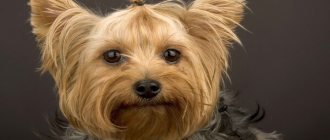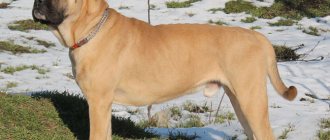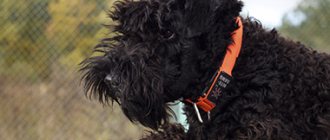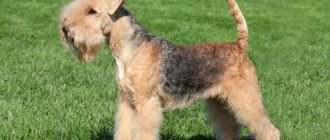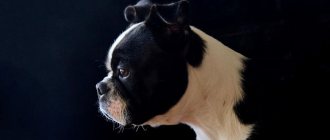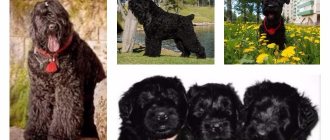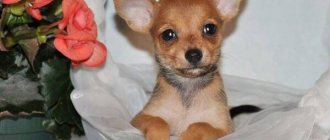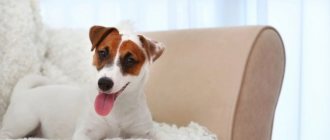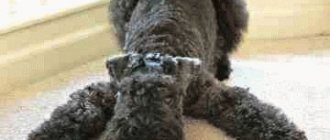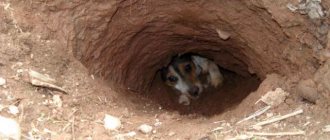The Irish Terrier is a born leader among dogs, capable of surprising its owner every day. In European countries it is called “sunny” because of its copper coat color, and in its homeland the dog received the nickname “devil” due to its fearlessness. The Irish Terrier has boundless courage, courage and hunting skills. Despite his stormy temperament and ability to make his own decisions, he becomes a true friend and loyal protector, capable of giving his life for the sake of his owner. From the article you will learn who this breed is suitable for and how to properly raise an obedient terrier.
brief information
- Country: Ireland.
- FCI class: Terriers (section No. 1 – large and medium terriers).
- Use: companion, hunting dog
- Color: Red.
- Life expectancy: 13-15 years.
- Average weight: Males up to 13 kg, females up to 12 kg.
- Height: 46-48 cm.
- Price: 20,000-40,000 rub.
Photo: needpix.com
Breed standard Irish Wheaten Terrier
Adult wheaten terriers weigh 13-20 kg. , height about 44-49 cm .
An elongated head with a flat skull rests on a medium-long neck. The ears are medium in size, hanging, raised on cartilage.
The eyes are relatively small and dark.
The stop is well defined. Muzzle of medium length. The nose is quite large and black. The jaws are strong. Scissor bite or straight bite.
The body is compact, elongated. The back is straight, the loin is short. The chest is deep, not too voluminous. The tail is set high. It is docked at 1/3 of the length.
The limbs are straight, of medium length, muscular. Small paws. Profitable fingers must be removed.
The coat of the Wheaten is different from that of other terriers; it is soft and silky rather than rough and harsh. The length of the hair is no more than 13 cm. It is wavy or curled, shiny.
Too fluffy fur, like that of a poodle, is not acceptable. It should fall, flow naturally.
Wheaten color of any shade (from light to golden-red).
Wheaten terriers with natural and trimmed, cropped hair are allowed at exhibition shows.
History of the origin of the breed
Today there is no documentary evidence of the origin of the breed. In Ireland, they believe that their terriers and wolfhounds appeared on the island even before the founding of the country, but official recognition of the breed occurred only in the middle of the 19th century.
The ancestor is believed to be the Welsh Terrier, brought from Britain to hunt rats and foxes. The first club for breeding Irish terriers appeared in Dublin in 1987, and it was its members who first began to talk about a ban on ear cropping in dogs of this breed. During the First World War they were used as messengers and trained to search for mines. The first Irish Terrier was brought to Russia after 1941 from Poland.
History of the breed
The birthplace of the Irish Terrier is Ireland. This breed is one of the most ancient on the globe. But it is officially believed that these dogs appeared in the mid-nineteenth century.
The history of the breed is not exactly known. There are different versions regarding its origin and regarding what types of dogs are the ancestors of the Irish.
According to one version, the direct ancestor of the modern Irish Terrier is a black and tan wire-haired terrier. It was bred two hundred years ago to hunt small rodents and foxes. Now, unfortunately, this breed is considered extinct.
Another version indicates that the Irishman’s ancestors include a large wheaten terrier. Lived in the area of the Irish county of Cork. He is also considered the progenitor of the Welsh and Lakeland Terriers.
There is another version, but it is the most implausible and little supported by facts. According to her, the Irish Terrier descended from the Irish Wolfhound. In other words, he is a smaller copy of a wolfhound. Of course, there is a relationship between these breeds, but it is very distant.
The Irish Terrier was officially recognized as an independent breed in 1870. After this, for nine years, breeding was carried out somewhat chaotically. Representatives of the breed were distinguished by a variety of sizes, colors and body types.
Breeders began breeding seriously in 1879. The purpose of breeding is to obtain standard Irish terriers with certain sizes and coat colors.
Representatives of the Irish breed were brought to the territory of the former Soviet Union from Poland in 1945, after the end of the war with Nazi Germany.
Description of the breed
Externally, the red terrier is a medium-sized dog with an athletic build, the body is proportional. The wool is colored in a rich red shade and has increased rigidity. Dirt does not stick to it; with high-quality trimming, the water should roll off. On the muzzle there is decoration in the form of a fluffy mustache and beard, the hairs of which stick out in different directions.
The Irish Terrier is a versatile dog. With quality training, it becomes a companion, suitable for gun and hound hunting, and is an excellent watchman. Due to the large number of lean muscles, the pet develops enormous speed and is the fastest and most resilient among terriers. Has innate curiosity, high intelligence and the ability to make independent decisions.
Standard
The first official FCI standards were published in 1955. There are still no exact limits for height and weight for males and females. Even within the same litter, puppies can differ in size. Evaluation criteria for this breed:
- Frame. The Irish Terrier's body is medium-sized, proportionate and athletic. You can draw a straight line from above that smoothly transitions into the arched hips. Structural pathologies are rarely observed in puppies.
- Limbs. The front and hind legs are long and very springy. The muscles are clearly visible on them; powerful pulsating vessels appear on the outer side of the thighs after exercise. Large pads of black color, covered with wool on top.
- Head. The skull is long, of a typical dolichocephalic type. A narrow head with a sloping forehead should taper towards the nose. The nose is large and uniformly black. A pronounced mustache is formed on both sides of the nose, and a goatee is formed on the lower jaw. A healthy dog has large lips painted black, which looks quite comical when the muzzle is completely trimmed. The teeth are powerful but proportional. Forms a strong scissor bite. According to the standard, the ears should be folded into a triangle and lie parallel to the skull. The eyes are dark brown, the light iris is a defect of the breed.
- Wool. In adult dogs of medium length, very stiff. It is colored a rich red color; in puppies there is a black tint, which fades with age. A small white spot on the chest is allowed. The wool is pleasant to the touch, its texture resembles thick velor. Dirt and thorns do not stick to it. Regular trimming is required at least 2 times a year.
- Tail. Medium length, should be slightly rounded towards the end, twisting into a ring is a defect. There is a thickening at the base; cupping is today prohibited by European standards (used only for medical reasons).
Watching the Irish Terrier in the ring is a real pleasure. Representatives of this breed move smoothly, placing their front paws a long distance forward. During an individual examination, the correctness of the bite and the location of the testicles in male dogs are checked for compliance with the standard.
Photo: wikimedia.org
Dog appearance (standards)
The Irish Terrier belongs to the terrier group, the section of large and medium-sized dogs.
Dimensions
These animals have a height of 45-48 cm and a weight of 11.5-12 kg.
Wool
The red terrier's coat is very thick and coarse. The hairs lie tightly to the body.
Water does not linger on the animal's coat, just as dirt and dust do not linger on it.
As soon as the dog shakes itself, all the garbage scatters to the sides, and the pet appears clean and tidy before the surprised viewer.
The highlight of the terrier is the mustache and beard sticking out in different directions.
Colors
The Irish Terrier is a cute redhead, a sunbeam that can be seen from afar. In addition to the red color, yellowish-red and reddish-wheaten are also allowed.
Head
The dog's head is narrow and long. It does not have a pronounced transition from the forehead to the muzzle.
Teeth and jaws
The jaws are very strong, the teeth are snow-white, even and strong.
Eyes
The eyes of representatives of the breed are small, shallow-set and quite close to each other. They are dark in color and always full of fire and intelligence.
Photo: https://pixabay.com/photos/dog-irish-terrier-garden-meadow-3580047/
Body and limbs
The body of the “saffron milk caps” is distinguished by its proportionality and harmony. Dogs have a straight back, a slightly convex loin, and a deep and muscular chest. The limbs are also straight and parallel. The rear ones are more muscular, set slightly wider than the front ones.
Tail
The high-set tail is covered with coarse hair that does not form a fringe. The tail should not be curled or thrown over the back.
Most often, the tail of Irish Terriers is docked, leaving three-quarters of the length.
Rock defects
Deviations in appearance on any of the above points are considered defects, the severity of which is determined by specialists.
Disqualifying defects include the following:
- undershot;
- snack;
- the nose is not black;
- male cryptorchidism;
- light eye color;
- color that does not meet the requirements.
Character and behavioral characteristics
When choosing an Irish Terrier as a pet, it is important to understand that the dog has a difficult character. This is a temperamental animal that always maintains a cheerful disposition and activity, but is subject to sudden mood swings. In Ireland they were nicknamed "the devil" because of their unique recklessness and lack of fear. An uncastrated male may rush at a larger and more powerful dog without assessing the consequences. All Irish Terriers are pugnacious and pick on other dogs and cats. This feature is manifested even in closely related mestizos.
The Irish Terrier adapts to being kept in an apartment; an aviary is not recommended for this breed. If you live in your own home, it is recommended to get a high fence - adult individuals can easily jump over high obstacles. The dog needs a lot of activity and physical activity. Running is the greatest pleasure for this breed. They easily follow a bicycle and reach speeds of up to 40 km/h in open areas. At the same time, the Irishman is extremely hardy; it takes several hours of active walks for the dog to begin to show fatigue.
Where can I buy an Irish Terrier puppy?
The breed is unpopular; you can only find a real Irish Terrier in an official kennel or club. Online stores or message boards are not the most reliable place to find and buy a puppy.
Such children often do not have the necessary documents, pedigree, medical card and passport. In addition, they may turn out to be mestizos with deviations not only in external standards, but also in health. In Russia you can contact nurseries:
- “Bold Soul” Samara;
- "Rus Dandy Lot" Moscow;
- "Abele's Star" Saratov;
- "Richley Red" Moscow.
Education and training
When training and raising an Irish Terrier, one should take into account the peculiarities of its physiology and temperament. The dog does not tolerate aggressive methods towards itself; it is undesirable to use radical methods of training. Thanks to their innate intelligence, representatives of this breed master commands well, but it is important to be patient - the Irish Terrier often shows stubbornness. You need to approach classes wisely, combine rewards with food, emotions, and also use gaming methods.
Owners of Irish Terriers should prepare for the fact that their pet will require a lot of time for walks and regular exercise. With a passive lifestyle, the dog becomes sad, often more so, and may begin to gain excess weight. At least 3 walks per day with a total duration of 3-4 hours are recommended. Conduct active exercises at least once a week; running in an open area, group exercises, coursing - running after a mechanical hare - are better suited for this purpose.
When getting a puppy, you should be prepared for consistent and long-term upbringing. It is important to teach the Irish Terrier to remain calm and self-possessed in the face of irritating factors, and to obey the owner unquestioningly. Unlike shepherds, training for Irish terriers should be short and positive for the dog, otherwise the Irishman will become distracted and stubborn.
History of appearance
Ireland is the birthplace of four terriers. Of all these terriers, the Irish terrier is considered the oldest. But how and when exactly he saw the light, no one knows.
There are suggestions that the breed traces its origins to wolfhounds, fortunately there is indeed a similarity in appearance. The second version claims that the breed descended from black-and-tan wire-haired terriers bred in the 18th century in England. Unfortunately, there is no documentary evidence about the history of the origin of red dogs.
But already in the 18th century, such dogs appeared among peasants, helping them manage livestock, in particular, herds of horses.
In 1875, dogs made their debut at the exhibition.
People liked the terrier breed, they began to involve the animal in other activities: protection and hunting. In the latter case, the dog proved to be an excellent specialist; it could hunt birds, foxes, otter and badger. And even such large animals as deer or roe deer did not frighten the four-legged hunter.
The Irish dog acts fearlessly, relying on its own strength and using its intelligence, and does not wait at all for a hint from the owner.
The first representatives of the breed were of different colors and had coats of different colors. The club of breed lovers, which was created in the 19th century, began breeding dogs and brought their appearance to a common denominator.
During the war, dogs were used as assistants to signalmen and orderlies; they were excellent at searching for mines. Nowadays, “red devils” are used in those places and professions that are associated with the search for drugs.
Today, the Irish dog has gained recognition throughout the world.
Mating
It is recommended to breed an Irish Terrier no earlier than the second heat in order to avoid diseases of the reproductive organs in old age. The optimal age is 2 years, the mating itself is planned for 10-14 days. It is imperative to select a pair for this breed, since its representatives may differ in size. The male and female should be approximately equal in weight, height and size, this will avoid fetal death and caesarean section.
Conduct introductions only on the bitch’s territory, which is important to reduce anxiety, especially in young dogs. During mating, you must not scare the animals, make loud noises or invite strangers home. Control mating is usually carried out after 1-2 days. In large nurseries I practice artificial insemination, which is much more comfortable and painless for the animals.
Breed health
These dogs are relatively healthy and suffer almost no genetic diseases.
If we do not take into account diseases of the gastrointestinal tract, cardiovascular system, etc., which occur in the vast majority of dogs, we can identify only a few diseases characteristic of the Irish:
- hip dysplasia
- von Willebrand-Diana disease
- hypothyroidism
- hyperkeratosis of the paw pads
At one time, hyperkeratosis did not manifest itself in any way in animals and dog breeders breathed a sigh of relief, thinking that it had disappeared forever. But, as it turned out, it was in vain. Recently, more and more Irish Terriers are suffering from the disease. Hyperkeratosis is transmitted only genetically, and both parents must have the gene for the disease.
Pregnancy
In the Irish, pregnancy normally lasts up to 56 days. Throughout gestation, reduce physical and emotional stress, which can cause the death of the entire litter. It is recommended to increase nutrition and the number of daily servings themselves, as well as give vitamin supplements. The litter size for this breed is 4-6 puppies; it is advisable to give birth only in a veterinary clinic.
Irish Terrier bitches have good maternal instincts, but the activity inherent in the breed is noted from the first months of life. Puppies are very playful and active, it is advisable to get a large cage for the whole family. Puppies can be adopted after 3-4 months and undergoing the necessary vaccinations.
Photo: wikimedia.org
Breed card
- Known breed names : Irish Terrier, Irish Red Terrier, Irish Soft Coated Wheaten Terrier, Irish Red Terrier
- FCI breed number: 139
- Description of the standard on the FCI website: link
- Height at withers: up to 45.5 cm
- Adult dog weight: 11-14 kg
- Color options: wheaten, red, golden
- Life expectancy: up to 17 years
- Puppy cost: 20,000-35,000 rubles
- Size: 3 out of 5
- Learning ability: 4 out of 5
- Attitude towards children: 4 out of 5
- Shedding intensity: 2 out of 5
- Protective and guard qualities: 5 out of 5
Care
Despite its complex character, the Irish Terrier is easy to care for. The breed is suitable for living in a small apartment. Its huge advantage is that the animal does not shed; with regular plucking, the hairs practically do not remain on the surface of the furniture or the floor. Irish Terrier care rules:
- Frequent bathing is not recommended; there is practically no dirt left on the coat after walks;
- Trimming should be carried out at least 2 times a year; specialists carry out the procedure only with their fingers; the remaining hair can usually be removed with a pumice stone. The ideal situation is when a little old hair remains, but new ones are already beginning to grow - this creates volume and enhances texture;
- it is necessary to regularly check the ears and clean them of excess wax;
- claws need to be trimmed as they grow, and additional hair on the paws must be removed;
- After eating, owners recommend brushing the beard, otherwise food residue will end up on the furniture and the pet will begin to wipe itself off on its own.
The dog must have its own place in the apartment where it can sleep and relax. It is recommended to purchase a bowl with an adjustable height - the large length of the legs creates inconvenience when feeding from containers on the floor.
Photo: wikimedia.org
Terrier character
The Irish Terrier is a true Celt, having an independent character and standing out from the general crowd with reckless courage. He will not fail to demonstrate his determination to the world; he will achieve his goal in any matter. He will spend the entire path to achieving this goal in a state of complete concentration.
The momentary recklessness that a dog often demonstrates is a legacy of distant ancestors. In the Irish, it is combined with noble behavior and absolute unpretentiousness in content.
The red terrier will not be completely re-educated. Endurance, courage and audacity will remain with him forever.
This must be taken into account when raising and training your pet.
Another name for the dog is “brave devil.” Representatives of the breed very often conflict with other dogs. It is worth noting that the staunch Irish, with a sense of self-respect, will fight to the last, regardless of the wounds received in battle.
The fiery temperament of a fire dog does not in any way affect its endurance.
Having flared up in one second, like gunpowder, the animal will also instantly freeze in place, only hearing the owner’s cry. The sound of a loved one's voice has a magical effect on a dog. In addition, she perfectly understands the owner’s intonation.
The Irish Terrier is very intelligent and has an enviable intuition. He will never get lost even in an unfamiliar area.
Photo: https://pixabay.com/photos/dog-irish-terrier-terrier-brown-682236/ “Sunny saffron milk cap” is a bundle of contradictions. He can be stubborn and obedient, affectionate and angry, loyal and freedom-loving.
The Irish are born clowns with an amazing sense of humor.
But a proud dog will not tolerate evil and offensive ridicule.
Attitude towards the owner
It’s worth paying special attention to the red-haired Irishman’s attitude towards his family. The animal loves everyone, without pushing anyone away or bypassing anyone. It looks after everyone equally and cares about everyone equally.
The animal has a special relationship with its owner; the dog is completely devoted to him; it always listens to the voice and commands of its loved one.
The Irish dog is a born leader. She will only accept an owner who will assert his superiority without resorting to violence and rudeness.
This animal is not recommended for older people, as well as for those who cannot devote enough time to a new family member.
“Golden Handsome” is an excellent companion and loyal friend who will adapt to the life of any person and keep him company in any business. The terrier will not refuse a walk in nature, will not resist if the owner decides to go for a run or bike ride, and will simply be there in difficult times, providing support with his loyalty and making him smile in response to the dog’s inexhaustible positivity.
Attitude towards children
The Irish dog treats children very well, taking care of them and happily taking part in joint games. A cheerful and open character helps the animal find a common language with little people.
Children should be taught from an early age to respect the personal space of a four-legged family member and not to impose their company on him if the dog does not want it.
No matter how peaceful your pet may be, you still should not leave him alone with your beloved child.
Attitude towards strangers
Even in ancient times, dogs made good guards, who have not lost their skills to this day. Representatives of the breed are distrustful and wary of strangers who will not be allowed beyond the threshold. If the dog decides that a stranger is dangerous, it will not only growl, but may also attack him.
Owner reviews
Julia K. “We got an Irishman, this was our first dog. The biggest challenge with this breed is the need for exercise. We walk with Tru at least 4 hours a day, sometimes this is not enough. Despite his activity, he doesn’t chew the furniture at home and behaves with dignity.”
Victor M. “Fell in love with the Irish terrier at first sight. This is a very smart, hardy and active breed. I spend a lot of time outside with my pet and take him with me on bike rides. I came across the fact that Patrick constantly gets into fights, sometimes it’s difficult to stop him. Signed up for OKD, I hope it helps.”
Character
The Wheaten Terrier is endlessly devoted to his family. He needs communication with people. This active and friendly dog treats all household members almost equally, although more respectful behavior and stricter obedience are noted in relation to the owner.
Representatives of this breed often show stubbornness and willfulness. To achieve their goal, they come up with various tricks and tricks.
If you show weakness once, it will be difficult to achieve complete obedience from the terrier in the future.
He gets along well with children, but such a pet is not suitable for a child under 6 years old. The terrier will not tolerate too free treatment for a long time.
Children should know that animals must be treated with care and kindness, but not rudely.
The Wheaten Terrier, although currently a family dog, has the genes of a skilled hunter.
The terrier is not suitable for guard duty, since it has no aggression towards humans. Such a dog may show wariness towards a stranger, may bark at a stranger, but will attack with anger and will not bite.
Aggressiveness in the Wheaten Terrier is manifested only in relation to the intended prey.
That is why it is not recommended to keep small rodents and ornamental birds in the same house with wheat. Although each dog is individual in its own way.
The terrier develops normal friendly relations with his own kind. But in any case, he will try to dominate, to subjugate other dogs to his will. Conflicts sometimes arise on this basis.
Advantages and disadvantages
Advantages of the breed:
- activity, curiosity and playfulness;
- pronounced intelligence, ability to learn;
- easy care, no shedding;
- beautiful exterior;
- possibility of training as a hunter, versatility.
Disadvantages include a short temper, physical demands, and emotional instability. The breed is not recommended for novice dog breeders.
Photo: pixabay.com
Briefly about the main thing
- The Irish Terrier is a medium-sized, wire-haired dog. Brought out in Ireland, active distribution occurred in the 19th century.
- The physique is proportional and athletic. The fur is colored red, and there is a beard on the lower jaw.
- The terrier does not get along well with other dogs and cats. It is distinguished by pugnacity and lack of fear of danger.
- This is an intelligent and inquisitive animal that is easy to train. He is highly emotional and has a bright temperament.
- Care is not particularly difficult, but regular trimming is required. The breed is not recommended for beginners due to its stubbornness during training.
Upbringing
A representative of the breed should be raised with caution in terms of punishments. Sometimes it is better to turn a blind eye to an animal’s tricks than to provoke negative emotions with screaming or physical punishment. The pet remembers injustice for a long time. Therefore, in relation to the Irish Terrier, it is better to give him more freedom - for this he will thank the owner with respect and diligence.
Due to the innate waywardness of the Irish Terrier, it is not recommended for novice dog owners to own an Irish Terrier: not everyone can cope with such a freedom-loving character.
Photo
Photo: flickr.com
Photo: flickr.com
Photo: wikimedia.org
Photo: wikimedia.org
Photo: wikimedia.org
Photo: wikimedia.org
Photo: wikimedia.org
Photo: pixabay.com
Photo: pixabay.com
Photo: pixabay.com
Photo: pexels.com
